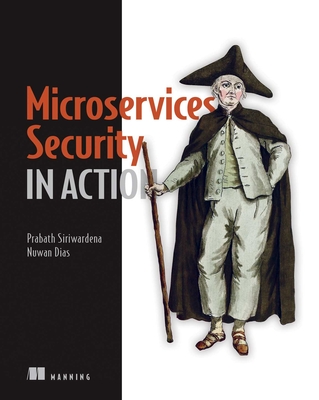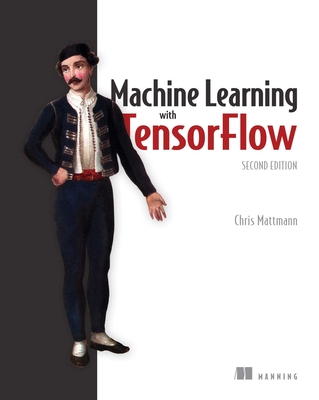Machine Learning with Tensorflow, 2/e (Paperback)
暫譯: 使用 TensorFlow 的機器學習(第二版)
Chris, Mattmann A.
- 出版商: Manning
- 出版日期: 2021-02-02
- 售價: $1,800
- 貴賓價: 9.5 折 $1,710
- 語言: 英文
- 頁數: 456
- 裝訂: Quality Paper - also called trade paper
- ISBN: 1617297712
- ISBN-13: 9781617297717
-
相關分類:
TensorFlow
-
相關翻譯:
TensorFlow 機器學習 (原書第2版) (簡中版)
立即出貨 (庫存=1)
買這商品的人也買了...
-
 Learning From Data (Hardcover)
Learning From Data (Hardcover)$1,200$1,176 -
 RabbitMQ 實戰指南
RabbitMQ 實戰指南$474$450 -
 $352Akka 實戰:快速構建高可用分佈式應用
$352Akka 實戰:快速構建高可用分佈式應用 -
 Big Data Analysis with Python (Paperback)
Big Data Analysis with Python (Paperback)$1,320$1,254 -
 Hands-On Computer Vision with Tensorflow 2
Hands-On Computer Vision with Tensorflow 2$1,395$1,325 -
 $1,464Deep Learning with TensorFlow 2 and Keras, 2/e (Paperback)
$1,464Deep Learning with TensorFlow 2 and Keras, 2/e (Paperback) -
 機器學習的數學基礎 : AI、深度學習打底必讀
機器學習的數學基礎 : AI、深度學習打底必讀$580$458 -
 Advanced Deep Learning with TensorFlow 2 and Keras - Second Edition
Advanced Deep Learning with TensorFlow 2 and Keras - Second Edition$1,500$1,425 -
 $1,584Microservices Security in Action
$1,584Microservices Security in Action -
 Mathematics for Machine Learning (Paperback)
Mathematics for Machine Learning (Paperback)$1,520$1,490 -
 $454中臺戰略:中臺建設與數字商業
$454中臺戰略:中臺建設與數字商業
相關主題
商品描述
Updated with new code, new projects, and new chapters, Machine Learning with TensorFlow, Second Edition gives readers a solid foundation in machine-learning concepts and the TensorFlow library.
Summary
Updated with new code, new projects, and new chapters, Machine Learning with TensorFlow, Second Edition gives readers a solid foundation in machine-learning concepts and the TensorFlow library. Written by NASA JPL Deputy CTO and Principal Data Scientist Chris Mattmann, all examples are accompanied by downloadable Jupyter Notebooks for a hands-on experience coding TensorFlow with Python. New and revised content expands coverage of core machine learning algorithms, and advancements in neural networks such as VGG-Face facial identification classifiers and deep speech classifiers.
Purchase of the print book includes a free eBook in PDF, Kindle, and ePub formats from Manning Publications.
About the technology
Supercharge your data analysis with machine learning ML algorithms automatically improve as they process data, so results get better over time. You don't have to be a mathematician to use ML: Tools like Google's TensorFlow library help with complex calculations so you can focus on getting the answers you need.
About the book
Machine Learning with TensorFlow, Second Edition is a fully revised guide to building machine learning models using Python and TensorFlow. You'll apply core ML concepts to real-world challenges, such as sentiment analysis, text classification, and image recognition. Hands-on examples illustrate neural network techniques for deep speech processing, facial identification, and auto-encoding with CIFAR-10.
What's inside
Machine Learning with TensorFlow
Choosing the best ML approaches
Visualizing algorithms with TensorBoard
Sharing results with collaborators
Running models in Docker
About the reader
Requires intermediate Python skills and knowledge of general algebraic concepts like vectors and matrices. Examples use the super-stable 1.15.x branch of TensorFlow and TensorFlow 2.x.
About the author
Chris Mattmann is the Division Manager of the Artificial Intelligence, Analytics, and Innovation Organization at NASA Jet Propulsion Lab. The first edition of this book was written by Nishant Shukla with Kenneth Fricklas.
Table of Contents
PART 1 - YOUR MACHINE-LEARNING RIG
1 A machine-learning odyssey
2 TensorFlow essentials
PART 2 - CORE LEARNING ALGORITHMS
3 Linear regression and beyond
4 Using regression for call-center volume prediction
5 A gentle introduction to classification
6 Sentiment classification: Large movie-review dataset
7 Automatically clustering data
8 Inferring user activity from Android accelerometer data
9 Hidden Markov models
10 Part-of-speech tagging and word-sense disambiguation
PART 3 - THE NEURAL NETWORK PARADIGM
11 A peek into autoencoders
12 Applying autoencoders: The CIFAR-10 image dataset
13 Reinforcement learning
14 Convolutional neural networks
15 Building a real-world CNN: VGG-Face ad VGG-Face Lite
16 Recurrent neural networks
17 LSTMs and automatic speech recognition
18 Sequence-to-sequence models for chatbots
19 Utility landscape
商品描述(中文翻譯)
更新了新代碼、新專案和新章節的《使用 TensorFlow 的機器學習(第二版)》為讀者提供了機器學習概念和 TensorFlow 函式庫的堅實基礎。
**摘要**
更新了新代碼、新專案和新章節的《使用 TensorFlow 的機器學習(第二版)》為讀者提供了機器學習概念和 TensorFlow 函式庫的堅實基礎。這本書由 NASA JPL 副首席技術官及首席數據科學家 Chris Mattmann 撰寫,所有範例均附有可下載的 Jupyter Notebook,以便讀者親自體驗使用 Python 編寫 TensorFlow 的過程。新的和修訂的內容擴展了核心機器學習演算法的涵蓋範圍,以及在神經網絡方面的進展,例如 VGG-Face 面部識別分類器和深度語音分類器。
購買印刷版書籍可獲得 Manning Publications 提供的免費 PDF、Kindle 和 ePub 格式電子書。
**關於技術**
透過機器學習來強化您的數據分析,機器學習演算法會隨著處理數據而自動改進,因此結果會隨時間變得更好。您不必成為數學家就能使用機器學習:像 Google 的 TensorFlow 函式庫這樣的工具可以幫助進行複雜的計算,讓您能專注於獲得所需的答案。
**關於本書**
《使用 TensorFlow 的機器學習(第二版)》是一本全面修訂的指南,教您如何使用 Python 和 TensorFlow 構建機器學習模型。您將把核心機器學習概念應用於現實世界的挑戰,例如情感分析、文本分類和圖像識別。實作範例展示了用於深度語音處理、面部識別和自動編碼的神經網絡技術,並使用 CIFAR-10 數據集。
**內容概覽**
- 使用 TensorFlow 的機器學習
- 選擇最佳的機器學習方法
- 使用 TensorBoard 可視化演算法
- 與合作者分享結果
- 在 Docker 中運行模型
**讀者對象**
需要具備中級 Python 技能和一般代數概念(如向量和矩陣)的知識。範例使用超穩定的 TensorFlow 1.15.x 分支和 TensorFlow 2.x。
**關於作者**
**Chris Mattmann** 是 NASA 噴氣推進實驗室人工智慧、分析和創新組織的部門經理。本書的第一版由 **Nishant Shukla** 和 **Kenneth Fricklas** 共同撰寫。
**目錄**
**第一部分 - 您的機器學習裝置**
1. 機器學習的奧德賽
2. TensorFlow 基礎
**第二部分 - 核心學習演算法**
3. 線性回歸及其延伸
4. 使用回歸進行呼叫中心量預測
5. 分類的溫和介紹
6. 情感分類:大型電影評論數據集
7. 自動聚類數據
8. 從 Android 加速度計數據推斷用戶活動
9. 隱馬可夫模型
10. 詞性標註和詞義消歧
**第三部分 - 神經網絡範式**
11. 自動編碼器的初探
12. 應用自動編碼器:CIFAR-10 圖像數據集
13. 強化學習
14. 卷積神經網絡
15. 構建實際的 CNN:VGG-Face 和 VGG-Face Lite
16. 循環神經網絡
17. LSTM 和自動語音識別
18. 用於聊天機器人的序列到序列模型
19. 實用性景觀
作者簡介
Chris Mattmann is the Deputy Chief Technology and Innovation Officer at NASA Jet Propulsion Lab, where he has been recognised as JPL's first Principal Scientist in the area of Data Science. Chris has applied TensorFlow to challenges he's faced at NASA, including building an implementation of Google's Show & Tell algorithm for image captioning using TensorFlow. He contributes to open source as a former Director at the Apache Software Foundation, and teaches graduate courses at USC in Content Detection and Analysis, and in Search Engines and Information Retrieval.
作者簡介(中文翻譯)
克里斯·馬特曼是NASA噴氣推進實驗室的副首席技術與創新官,他被認可為JPL在數據科學領域的首位首席科學家。克里斯在NASA面對的挑戰中應用了TensorFlow,包括使用TensorFlow構建Google的Show & Tell算法的圖像標註實現。他作為Apache軟體基金會的前任董事,對開源做出了貢獻,並在南加州大學教授研究生課程,內容包括內容檢測與分析,以及搜尋引擎與資訊檢索。











